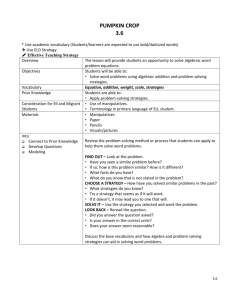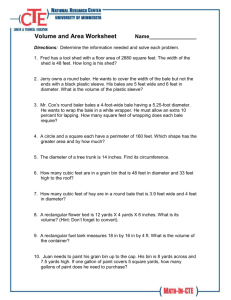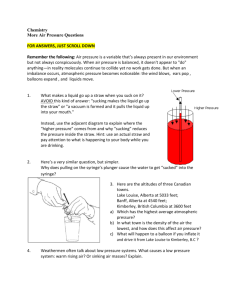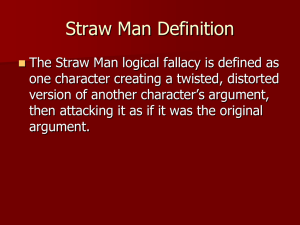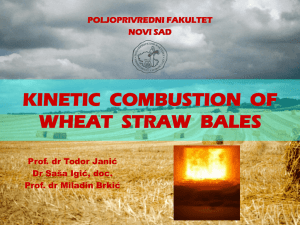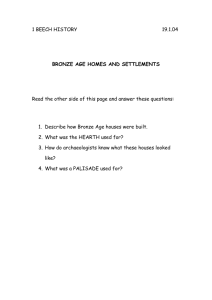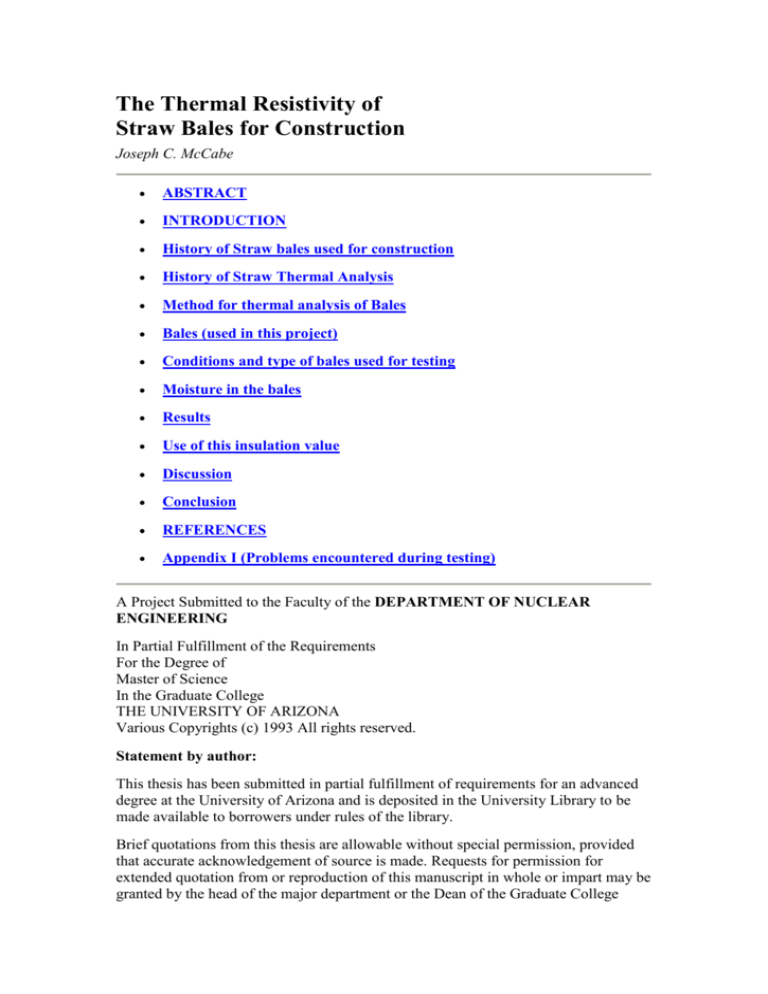
The Thermal Resistivity of
Straw Bales for Construction
Joseph C. McCabe
ABSTRACT
INTRODUCTION
History of Straw bales used for construction
History of Straw Thermal Analysis
Method for thermal analysis of Bales
Bales (used in this project)
Conditions and type of bales used for testing
Moisture in the bales
Results
Use of this insulation value
Discussion
Conclusion
REFERENCES
Appendix I (Problems encountered during testing)
A Project Submitted to the Faculty of the DEPARTMENT OF NUCLEAR
ENGINEERING
In Partial Fulfillment of the Requirements
For the Degree of
Master of Science
In the Graduate College
THE UNIVERSITY OF ARIZONA
Various Copyrights (c) 1993 All rights reserved.
Statement by author:
This thesis has been submitted in partial fulfillment of requirements for an advanced
degree at the University of Arizona and is deposited in the University Library to be
made available to borrowers under rules of the library.
Brief quotations from this thesis are allowable without special permission, provided
that accurate acknowledgement of source is made. Requests for permission for
extended quotation from or reproduction of this manuscript in whole or impart may be
granted by the head of the major department or the Dean of the Graduate College
when in his judgement the proposed use of the material is in the interests of
scholarship. In all other instances, however, permission must be obtained from the
author.
Acknowledgements:
I would like to thank the following for help in this thesis:
Lou Thompson for his brains, Matts Myhrman for his movement, University of
Arizona Environmental Research Laboratory for the facilities, Dr. Nader Chaulfoun
for his data, Dr Alphonso Ortega and Dr. Coates for their knowledge, Dr. Rocco
Fazzolari, Dr. William Fillipone and Dr. John Peck for their review and their
assistance.
And, mostly, thank you Dr. Cynthia Erickson for everything!
Dedication:
This thesis was written for all those who can benefit from the use of straw materials
for buildings, everyone.
ABSTRACT
This thesis describes the procedure for obtaining an insulation value for straw bales
for construction. A modified hot plate was placed between two bales and temperature
readings were taken at various locations in and on either sides of the straw bales, this
is referred to as a "modified guarded hot plate procedure".
An R-Value of 52 (H-FT^2-F/BTU-Bale) was determined for wheat bales. Rice straw
bales have similar insulating value. This R-value was used to demonstrate the energy
requirements of a residential building constructed with straw bales. The use of this
value has wide ranging implications on energy use for buildings. In order to compare
straw bale insulation to more traditional insulation materials the Arizona home energy
rating program, CalRes, was used. An average residential building energy usage
decrease of 12.4% per year was determined by using straw bales.
Straw is an anisentropic material. Insulating values of bales varies with position. Heat
flow against the grains has a higher insulating value (R=3.15/inch) than heat flowing
with the grains (R=2.38/inch). Moisture content and bale density also effect insulating
values.
INTRODUCTION
This thesis attempts to explain the history of straw bale construction; the problem of
no known values for the thermal resistivity of straw bales for construction; how
experimentally a value of the thermal resistivity was determined; and what this
insulating value can do for typical building designs.
History of Straw bales used for construction
The history of straw bale construction is an important portion of this thesis because it removes the
"Three Little Pigs" attitudes to this building technique.
Information from Out On Bale, Unlimited, a straw bale construction consulting firm
located in Tucson indicates the use of grass as a building material dates back to the
Stone Age, by which time humans were making extensive use of the enormous
grassland areas of the African and European continents.
The next logical progression toward bale buildings would be the use of such bundles
of stems as units to build a wall. Out On Bale, Un-Limited is presently trying to
confirm the existence, in Great Britain (Cheshire), of a slightly more than twohundred year old residence reportedly constructed by laying up long, tied bundles of
straw with an earthen mortar.
Nebraska residents have used straw for a building material for over 100 years.
Although there was a negative social stigma attached to living in a building made of
straw, these homes were practical, inexpensive efficient and sturdy. In fact several are
still standing today. Nebraska Historical Society located in Lincoln Nebraska has a
file on straw bale buildings in various counties in west and north Nebraska. Pictures
#1-3 show various views of these existing structures in Nebraska.
[5.1k]
[5.6k]
[6.7k]
Photos courtesy of Nebraska Historical Society, Lincoln Nebraska.
Straw bale construction flourished in the Sandhills of Nebraska more than any known location. Straw
was one of the only indigenous materials available to the sandhills area of northwest Nebraska. Bale
construction was an appropriate, sometimes necessary, response to a unique combination of legislative,
geologic, natural resource and socio-economic factors that prevailed in that region in the early 1900's.
The Kincaid Act of 1904 opened up the part of Nebraska that includes the Sandhills to
homesteading under new rules. Applicants could claim a full section (a one mile
square) rather than the quarter section previously allowed. This act brought large
numbers of financially pinched homesteaders into a nearly treeless, semi-arid region
characterized by vast areas of roadless, rail-less, grass-stabilized sand dunes.
Many inhabitants said that they, or others, had built bale houses as a temporary, stopgap measure to get the family under roof in the shortest possible time for the least
possible money. Many of them planned to build a "real" house as soon as enough
money could be saved. Such houses were often left exposed on the outside, while
plastered on the inside to enhance tidiness and prevent drafts. When the owners
finally believed that they were living in a "real" house, a process that sometimes took
as much as ten years, the outside walls would finally get a thick coat of mud plaster or
cement stucco. .1
As of this date (3/18/93), Out On Bale Un-Limited has solid documentation on eightyfive bale structures built since 1940, in Mexico, the United States, Canada and
Finland.
Climatically, the range of building sites includes semi-arid, southern Sonora, Mexico;
rainy, humid Alabama; wintry northern Alberta, Canada; and the coast of Maine. The
buildings run the gamut from a 10' by 12' storage shed, built by a 5th grade class with
rice straw bales, to an art gallery, to a 40' by 80' grocery store, to elegant homes, to a
26,000 square foot hog barn with a straw-insulated roof..2
Building of Railroads through the midwest is one factor that added to the reduction of
straw use. Railroads and merchandizing enabled wood products to replace Nebraska's
indigenous materials for buildings needs.
There has been a renewed interest in straw bale material because of environmental
interests and changing social values.
Recent renewed interest in straw bale construction makes engineering properties
associated with the material a necessity. What insulating value should be applied to
the straw bale wall? Energy designs can be compared with this important
characteristic. Sophisticated computer programs such as Calpas and DOE2 as well as
state energy rating programs such as Arizona's CalRes can predict the energy
consumption of a building using the known R-values. It is believed that this
information has not been available for straw bales previously.
The Department of Energy (DOE) estimates are that the home heating and cooling
energy usage in this country is 11% of the total U.S. energy consumption..3 Total
U.S. consumption was 74.2 Quadrillion BTU's in 1983..4 The straw bale insulating
material has great potential to reduce the residential sector building energy usage.
Houses built with straw bales have been constructed at costs of $20 to $75 per square
foot depending upon the sweat equity and extravagance of design compared to $45$75 of conventional home costs. Photographs 4 and 5 show the before workshop and
after views of a recent wall raising just south of Tucson downtown. This wall raising
took 3 hours to accomplish with the help of about 25 workshop participants.
[172k]
[179k]
{A post thesis note here, this bale structure burnt to the ground a few weeks after this picture was
taken. Located in the barrio district of Tucson, it highlights the need for immediate stucco for fire
proofing and precautionary steps.}
Bales don't provide great reductions in construction costs compared with conventional
building practices; however bales provide society with a reduced cost associated with
the environment and health. Agricultural wastes are typically burned; the straw bale
construction creates a demand for this material and reduces the burning. Recent
proposed California legislation will prohibit the burning of rice straw material. It is
possible that other states will enact similar legislation for other materials posing
threats to the environment.
The high thermal efficiency of straw bales reduce the energy requirements for heating
and cooling thus reducing pollution associated with energy to heat and cool dwellings.
This is an inexpensive high insulating material which does provide cost economies in
comparison with conventional high insulation costs. Bales can be a pollution
abatement program; the sequestering of yesterdays pollution in todays straw material.
Other value is to our old growth forests; trees can remain standing if the biannually,
renewable crop of straw is used as a replacement building material. The structural
capabilities of straw bale walls has been addressed in a 1993 paper by Galen Bouali a
civil engineering graduate student at the University of Arizona.
History of Straw Thermal Analysis
An extensive review of published materials uncovered articles on straw and straw
board materials in relation to the thermal and sound absorbing properties.
Published thermal properties of paddy straw particle boards were available in a paper
Mechanical and Thermal Properties of Particle Boards Made from Farm Residues.
Low- density particle board specimens with the following specifications were made
using ureaformaldehyde resin 6% (w/w) as the binding material, hot pressed under
1.47 MPa pressure and 170 C temperature for 15 minutes.
Board Size 0.225 X 0.25 X 0.016 m = 8.86" X 9.84" X .63"
Moisture content 11- 14 %
Particle size 5 - 10 mm long
Density 190 kg m^3 = 11.86 lbs/ft^3
The thermal properties were:
Porosity 55 %
Thermal Conductivity 226.0 Jm^-1h^-1C^-1= .0363 BTU/h-Ft-F= R value of 27.57/Ft
(R=2.29 h-Ft^2-F/BTU-in, similar to mineral fiberboard)
Specific heat 753.5 J kg^-1 C^-1 = 0.1799 BTU/lbm-F
Diffusivity: 44.46 10^-8 m^2 s^-1= 0.1724 Ft^2/h .5
These values include the bonding material and are not exactly representative
properties of the bales. The procedure for the testing to determine these numbers is
not known. Actual testing results from this project indicate that this R=2.29 h-Ft^2F/BTU-in value is close to the insulating value of bales with heat flowing with the
grains of the straw of R=2.38 h-Ft^2-F/BTU-in.
The Canada Mortgage and Housing Corporation, Housing Technology Incentives
Program, in Ottawa, Ontario, Canada has information on an innovative straw/bale
mortar wall system which describes the results of testing done in Canada on a sample
wall created by laying up straw bales (460mm or 18- 1/2" wide) with a cement-limesand mortar. A mixture of the same materials was then plastered onto each side to
create a layer 20mm (3/4") thick. These results indicated an average moisture content
of 13.36% and an insulative quality (RSI 6.17 or R-35)..6 As with the previous article
the procedure for this testing is not available.
Method for thermal analysis of Bales
Testing has followed to my best ability the guidelines set out by the American Society
for Testing and Materials ASTM, 1991 Standard Test Method for Steady-State Heat
Flux Measurements and Thermal Transmission properties by Means of the GuardedHot-Plate Apparatus. This test method covers the achievement and measurement of
steady-state heat flux through flat-slab specimens using a guarded-hot-plate
apparatus..7 It is used for board insulation, batt insulation and flat-slab specimens.
The testing was modified such that there was no cold plate. The cold plate was
replaced by sheet metal surfaces providing room temperature across the surface.
There was also no guard; the hot plate was surrounded by the insulating materials.
A special opportunity was available for me to use an adobe building at the
Environmental Research Laboratory near the airport in Tucson. A beautifully
landscaped facility provided a comfortable atmosphere for testing as well as
appropriate monitoring capabilities. Adobe mass provides a constant temperature
room to conduct testing. Temperature swings from 71.3 to 68.7 F dry bulb ( delta
temperature of 3.1 F) on March 18th and 19th were typical for the small temperature
swings throughout the beginning testing periods. Temperature swing of 2.6 F was
obtained during steady state conditions for the bundle on March 28th. The adobe
building came equipped with wet bulb, dry bulb and room radiant monitoring
equipment. These data points, bale thermocouple and heat flux sensors were wired
into the Omega portable datalogger, Model OM-372. This was linked via RS-232 to
an IBM-XT terminal where information was logged using Procomm communications
software running under DOS. Data was transferred to spreadsheet using Lotus and
computations and graphing performed by QuatroPro. Average reading values were
used for computations and graphing.
U of A Environmental Research Labratory[93k]
Thermocouple are T-type, blue and red insulation. Calibration of thermocouple was
performed using a calorimetric thermometer graduated at .2 degrees from 0 to 214
degrees F, a corrections table generated and applied to the data logger. Heat flux
sensors are Hycal Engineering B1- 7-120.
Computations for insulating properties was performed using ASTM Designation: C
1045 - 90 Standard Practice for Calculating Thermal Transmission Properties From
Steady-State Heat Flux Measurements..8
Testing was performed on blue polystyrene as a control (R-value of 5/inch) which
was compared to rice and wheat straw bales.
Bale bundles were the heart of the testing, for bales making up a bundle. Bundles
were produced in a systematic procedure. Plastic milk cartons were used to elevated
the bundles from the conduction of the adobe building brick floor. Banding straps
were placed on top of the milk cartons and taped in place for future banding
requirements. White painted 44" X 45"- 26 gauge sheet metal was place on top of the
milk cartons and straps. This standard white paint gave the surface an emissivity of
0.9. The first two bales were placed on the sheet metal. The heat source wrapped in
aluminum foil to distribute the heat and was centered upon the two bales. Four
thermocouple were Elmers glued to the heat source aluminum foil, two on the top and
two on the bottom at 6" away from the center lengthwise. The particular bale which
would have its internal temperature was placed on top of the first bale and the portion
of the heat source under it. This bale was carefully measured for thermocouple
placement. A pair of thermocouple was placed at the levels of 2", 5" and 10" from
heat source, . Thermocouple were also place on the internal surface of the bale to
determine the heat flow in the crack between the bales. The last bale was placed to
make the bundle. Three thermocouple were placed on the top surface of the bales. For
the wheat straw bundle a heat flux meter was placed on the top surface in the center of
the bundle. One piece of sheet metal was placed on the top, and the bundle was
banded together with 4 straps. Sheet metal was placed on the 4 sides remaining and
banded in place. Corners of the bundle had portions of straw materials showing
through the sheet metal. This was required so the bundle could be compressed by the
banding procedure. All thermocouple wires were exiting the bundle at the same
location while following constant heat flux paths in the interior of the bale bundle.
Pictures # 7 shows actual testing in the adobe building.
[168k]
Additional information obtained during testing was the volume of bales weight of
bales, the density and the percent moisture of bales being tested.
Not in the original report but for the net here we have animations of the testing. Click
on these images if you have FLI capabilities or Quicktime.
[463k Quicktime movie]
[120k FLI animation]
Temperature readings were at the heat source, bale surface, and at different levels in
the bales, 2", 5", and 10" from the heat source. Other testing included thermocouple
placed at the 1", 2", 3", 4.5", 6", 10" and surface positions. Heat flux metering was
placed at the heat source, 4.5" 10" and surface levels.
Room temperature, room wet bulb and dry bulb temperatures as well as room globe
temperatures were obtained.
Steady state operation was determined when the hot plate heat source did not vary
more than 1 degree F for a one day period. Voltage and current measurements were
obtained to the heat source.
The test procedure was to examine bales for consistency, record bale external
characteristics, and to measure the bale dimensions and weight.
The bales were positioned for cubic configurations such that the heat source is
sandwiched between two bales. The dimensions of the end of the heat source and the
bale surface dimensions were confirmed. This were used in edge loss and shape factor
corrections analysis.
The main goal was to obtain constant temperature readings through out a sample test
area of the bale. This was accomplished in steady state form after days of heating the
interior of the test module bundle. Testing indicated steady state operation was
obtained many days and in the case of the rice straw, weeks after the heating began.
Thermocouple were placed on the heat source and at various levels of the bale, and at
the bale surface. The placement of thermocouple was suggested by ASTM C 1045909 with at least 2 thermocouple at each level.
The energy to the heat source was regulated so the temperature remains constant. This
was done with a DC power supply. The heat source is a radiant heat panel by Aztec.
This normal 200 watt rating 15" X 23.5" panel was attached to a 25 volt DC power
supply to regulate power to the heating device. The voltage and current is measured
with a Fluke model 8012A and a Hewlet Packard model 6215 A.
The DC power supply regulated the power into the hot plate for straw high
temperature testing at
Voltage=25.3 Volts DC
Current=0.341 Amps
For a wattage of (V*I)=8.63 Watts=29.4 BTU/hr
Power was reduced for the polystyrene testing and low temperature bale testing. The
heat flux metering was used for determination of actual heat flow in the bales and
polystyrene tests.
Thermocouple were calibrated before using. Voltage corrections for specific
thermocouple were programed into the Omega data logger. Temperature readings
were logged on 10 minute intervals. When the hot plate temperature no longer varied
more than 1 degree for the day average steady state condition was assumed. A delta
temperature across the bale was measured and applied to the equations for insulating
value.
Background on bales used in this project
Bales from farms have varying volumes and banding schemes. New Mexico bales are
typically 2 band, Yuma bales are 3 plastic wraps. 3 plastic wrap norther California
rice straw bales were shipped for this experiment. Bales of various materials are
available. Straw comes from rice, oats, wheat, etc. The bales used for this project
were rice straw bales and wheat straw bales.
Bales range in size from 50 to 80 lbs and sizes 35"-47" long, 14-16.5" high and 18"23" wide..10 Drawing # 1 illustrates these dimensions. These dimensions orientation
the fibrous material of the bale horizontal. Bales have been oriented in various
positions in building construction. Testing the properties was done in the horizontal
and vertical positions. If the bales of a wall are vertical straw materials the wall
thickness (16.5" heat flow against the grain) is less than if the straw is horizontal (23"
heat flow with the grain) and there is less insulating value per inch. The heat flow
during comparison testing was perpendicular to the strands of straw, the 16.5"
dimension or height of bale. Testing was also performed on the bales to determine 23"
length insulating value, called "on end" testing. Typical building practice uses either
orientation.
These bale tests were compared with the same test method performed on pieces of 4"
thick polystyrene, having a known insulating value of R=5 h-Ft^2-F/BTU-in. These
pieces of polystyrene were positioned for a cubic arrangement of 48" X 48" X 32",
similar to the bale cubic arrangement. These comparisons provide similar edge and
corner loss comparisons.
Conditions and type of bales used for testing
This thesis used two different types of straw materials. Wheat straw bales were
obtained from a warehouse in Tucson. Rice straw bales were shipped from Northern
California. All bales had been unused, 3 string bales dimensions and weight of the
bales used as shown in Table # 1.
Weight of bales and density were measured in an attempt to follow the ASTM
Thickness and Density of Blanket or Batt Thermal Insulations..11 This method had
applicable guidelines for proper apparatus, however the batt insulation expansion
procedure was not applicable because of the varying surfaces of the bales; the bale
length is shorter where the ties are, the bales bend and have pockets of straw sticking
out. To the best extent accurate measurements were performed, however all
dimensions should have a + or - 1/2" discrepancy because of difficulty in
measurements.
The method for bale moisture has not been addressed with standard procedural
process. It is a unique measurement for our applications.
Conditions and type of bales used for testing
This thesis used two different types of straw materials. Wheat straw bales were
obtained from a warehouse in Tucson. Rice straw bales were shipped from Northern
California. All bales had been unused, 3 string bales dimensions and weight of the
bales used as shown in Table # 1.
Weight of bales and density were measured in an attempt to follow the ASTM
Thickness and Density of Blanket or Batt Thermal Insulations..11 This method had
applicable guidelines for proper apparatus, however the batt insulation expansion
procedure was not applicable because of the varying surfaces of the bales; the bale
length is shorter where the ties are, the bales bend and have pockets of straw sticking
out. To the best extent accurate measurements were performed, however all
dimensions should have a + or - 1/2" discrepancy because of difficulty in
measurements.
The method for bale moisture has not been addressed with standard procedural
process. It is a unique measurement for our applications.
Moisture in the bales
Testing performed for this thesis represents a small sample of bales. Bales used for
construction should have the driest possible conditions for greatest insulating value.
Dry bales have higher insulating values than bales with moisture because the moisture
migration transfers heat.
Wheat straw has 28% moisture content when fresh cut weight, rice straw 20%..12
Typical bales have 14% moisture. However the industry does not track statistics for
moisture percentage values. Two types of moisture values are important to the
agricultural industry. First is the quality, dry bales last longer and don't rot. The
second is marketing. Marketing is important because of the value of the straw not the
water. Bales are penalized for being wet..13 The moisture content is important in
determining the insulation properties of the bale material without the effect of water,
moisture. The method for determining water content or this thesis was to break open
the center of a bale, and obtain a representative sample of the interior straw. This
straw was weighed, and heated for days at 100 C, then weighed again. The difference
of the weights is the moisture removed. The bale was banded together and used in the
test bundle.
Percent moisture of bales were obtained before and after the testing of the wheat
bales. Percent moisture tests of a the rice straw bales which were dried on a sun porch
at a temperature of 103-110 F during sunny days provided an 8.4% moisture content.
The percent moisture test of the rice straw used in the thermal testing was determined
after the testing of the test bundle bales.
TABLE # 1
Straw Bale Characteristics
Bale Type
#
1
Wheat
2
Wheat
3
Wheat
4
Wheat
Average
St. Dev.
5 Rice
6 Rice
7 Rice
8 Rice
Average:
Std. Dev.
Bale
#
1
2
3
4
5
6
7
8
Wheat Ave
Rice Ave:
Dim (in inches)
Weight
%
hgt
wth
length
lbs
Moisture
16.7
22.5
44.4
84
8.4%
16.7
22.5
44.5
80
8.4%
16.0
23.5
47.0
83
8.4%
16.3
23.0
46.7
84
8.4%
16.4
22.9
45.6
82.7 8.4%
+.34
+.48 +1.39 +1.89
16.5
23.0
45.5
77
8.2%
15.5
23.5
44.5
76
8.2%
16.5
23.0
45.5
79
8.2%
16.5
23.0
44.5
71
8.2%
16.2
23.1
45.0
75.7 8.2%
+.5
+.25
+0.6
+3.4
Volume
Density
ft^3
lbs/ft^3
19.68
8.68
9.71
8.24
10.23
8.12
10.14
8.28
10.03
7.68
9.42
8.07
10.03
7.88
9.80
7.24
9.94+.29
8.33+.24
9.82+.29
7.72+.36
Percent moisture was one of the biggest problems in obtaining a steady state
condition. This problem provides information regarding the typical bales used for
construction. Materials are cut in the field and laid out to dry. The length of time
material stays in the field depends upon the weather; ideally it is collected and baled
in its driest possible state. Wheat bales tested 8.2 to 8.4 % before and 5.9% after the
bundle thermal testing; this shows that drying out during the testing. It has been the
findings of this experiment that the straw samples do not dry out more than 5%
moisture when the heat is applied for extended periods. Bales could have been placed
in ovens and dried at extreme temperatures, but this would not provide typical
building material information. It was assumed that the material reaches an equilibrium
of moisture content dependent upon relative humidity and temperature. See Appendix
for more information on problems during testing.
Results
The steady state condition took a long time to achieve because of moisture problems
in the bales. The rice straw had considerable moisture, taking two weeks to reach a
steady state condition. The values of temperature readings for the horizontal position
of the rice and wheat straw bales are:
TABLE # 2
3_28_93 Horizontal after steady state, rice straw, average temperatures of
thermocouple readings:
Hot Plate 2" Ave. 5" Avg. 10" Avg.Surf
Average: 142.9 123.7
108.3
89.5 70.5
Minimum: 142.6 123.5
108.2
89
68.3
Maximum: 143.2 123.9
108.5
89.7 72.7
Room W.B. Room D.B
Average:
59.3
67.8
Minimum:
58.8
66.3
Maximum:
60.1
68.9
4_6_93 Horizontal after steady state, wheat Straw average temperatures of
thermocouple readings:
Hot Plate
Ave 144.4
Max 144.8
Min 143.8
2" Ave
131.1
131.5
130.5
5" Avg
109.0
109.5
108.3
10" Ave
90.0
90.3
89.8
Surf Ave.
76.0
77.2
74.9
Room W.B. Room D.B.
Ave:
Min
Max:
61.1
62.4
59.9
69.9
71.6
68.3
These tests are illustrated in the Graph # 1 "Rice Straw, Horizontal Steady State
3_28_93 Ave Temps" and Graph # 2 "Wheat Straw Horizontal Steady State 4_6_93
Average Temperatures".
[7.2k]
[6.7k]
It was found that a temperature versus distance graphing of the test provided near
straight line relationship from the hot plate to the 6" level in the straw bundles. This
can be seen in the graph Temp vs Distance 4_18 Wheat Low Temp, Graph #3.
[5.6k]
Polystyrene insulation with a known insulation value of R=5/inch was tested in the
same manner as the bales. An R- value of 4.9 was experimentally determined in the
bundle configuration using heat flux measurements at the 4.5" level and a delta
temperature of hot plate minus the 4.5" level. This same method was used on wheat
bales in the horizontal, low and high delta temperature and "on end" positions.
Graphical representation of these comparative tests are shown in Graph #4, #5, & #6.
The results for these tests are as follows:
[5.6k]
[5.6k]
[5.6k]
TABLE #3 Results of Bale Bundle Testing Compared With Polystyrene
Type
q
Delta
u
R for
of
Temp
4.5"
Bale
Wheat 2.33 31.0 0.075 13.3
Wheat 1.39 19.7 0.071 14.2
Low Temp
Poly- 1.44 31.9 0.045 22.2
styrene
Wheat 1.59 17.0 0.09 10.7
on end
R for R for
1"
Bale
2.96
3.15
48.8(16.5")
52.0(16.5")
4.93
2.38
54.8(23")
Units are: q-(BTU/FT^2-H), u-(BTU/FT^2-H-F), R-(H-FT^2- F/BTU-inch)
Graph # 7, R-Value per inch illustrates these results.
[5.6k]
Use of insulation value
Typical building design analysis information is available to compare conventional
building techniques with the straw bale. For this thesis I have performed computer
energy simulations of existing designs which are presently being built and meet
current Arizona energy use requirements. These simulations are done with a program
called CALRES/Arizona, a computer program developed for the Arizona Energy
Office by Berkley Solar Group Software for the Arizona Home Energy Rating
System.
CALRES/Arizona is a design tool used to compare design strategies. For this project
the high insulation properties of the straw bale is compared with the typical R-11 and
R-19 wall insulation used in todays buildings. The exterior convection, interior and
exterior surface materials remain unchanged. These data files were obtained from a
study for Southwest Gas performed by Dr. Nader Chaulfoun at the University of
Arizona Department of Architecture. The names of the construction designs have
been withheld because of their unimportance to this thesis; the important information
is the energy usage comparison of existing building techniques to that of the straw
bale construction. Building designs were chosen at random for small to medium size
structures. Tucson Arizona is the weather file used, the worst case orientation to the
sun was used with the largest window facing west. There were no stucco or adobe
surfaces applied to the simulation, only the inside and outside convection with an
R=52 insulation value.
A review of the results are:
TABLE # 4
Calres Arizona Comparison of Homes
Weather Data Tucson AZ.
Calres Arizona Comparison of Homes
House
#
SQ. FT.
1
1211
2
1132
3
1400
4
1305
5
1596
6
1504
7
1523
Original (kBtu/ft2-yr)
Heating Cooling Total
23.02
23.78
46.8
28.81
69.32
98.13
17.57
38.12
55.69
16.54
34.62
51.16
14.32
36.13
50.45
14.28
39.38
53.66
23.6
23.17
46.77
Weather Data Tucson AZ.
House
With
#
Heating
1
18.33
2
23.49
3
14.83
4
14.71
5
12.87
6
12.44
7
18.06
Straw (kBtu/ft2-yr)
kBTU/yr
Cooling Total Savings %savings
21.21
39.54
8791
15.5%
60.82
84.31
15644 14.1%
34.34
49.17
9128
11.7%
31.59
46.3
6342
9.5%
33.73
46.6
6144
7.6%
36.21
48.65
7535
9.3%
19.79
37.85
13585 19.1%
Average:
12.4%
This is a significant decrease in energy usage.
Discussion
Insulation value of straw bales for construction has great implications for reducing
residential energy consumption. The Department of Energy predicts that energy end
use in U.S. residential and commercial buildings for space heating and cooling was
9.5 quadrillion BTU's in 1990 and will be over 11 Quadrillion Btu's in the year 2010.
In Tucson Arizona the percentage of residential energy usage for cooling is much
higher than the national average at 49%, lower for heating at 16%. This energy usage
is what straw bale construction can reduce without reducing comfort or air changes
per hour.
Recently there have been laws created to ban the burning of field straw. This material
is currently a waste product for the farmers. Along with these laws, high disposal
costs will increase usage of straw for construction.
Conclusion
Straw bale construction has high insulating value of R=52 for a 16.5" bale width with
typical home temperatures. Rice straw is similar to wheat straw in its insulating value.
The positioning of straw bale does have an effect on the insulating value of the bale.
Heat traveling against the grains of the straw has a greater insulating value that heat
traveling with the straw grains. Home energy usage can be reduced by 12.4% by using
this building material.
This project demonstrates the great impact straw bales can have on the residential
energy usage heating and cooling usage. Utility companies can benefit from this
reduction in conduction of heat when the need to reduce energy usage is greatest,
when it is hot out. Typical demand side management DSM programs look for
opportunities to reduce the peak energy usage of the year so that new power plants
don't have to be constructed for this peak energy usage. Straw bale construction can
help to reduce this peak energy usage, as well as bring the whole yearly demand curve
down.
The Thermal Resistivity of
Straw Bales for Construction
Joseph McCabe
References
1 Myhrman, Matts, interviewed by Joseph McCabe, Tucson, AZ., 2 P.M., April 6,
1993RETURN
2 Myrman, Matts, April 22, 1993 Architecture and the Great Plains: The Built
Environment, Past and Present symposium. Work in progress.RETURN
3 Mcpherson, E. Gregory, "Benefits and Costs of Energy- Conserving Site Design",
American Society of Landscape Architects, 1984RETURN
4 U.S. Department of Energy/ Energy Information Administration (1992) Annual
Energy Outlook 1984 (DOE/EIA-0383(84)) Washington, D.C.: U.S. Government
Printing Office II.RETURN
5 A. Sampathrajan, N.C. Vijayaraghavan & K.R. Swaminathan, "Mechanical and
Thermal Properties of Particle Boards Made from Farm Residues", Bioresource
Technology 0960-8524/92 p 249-251RETURN
6 Canada Mortgage and Housing Corporation, Housing Technology Incentives
Program, Ottawa, Ontario, Canada, K1A OP7. 1984. An innovative straw/bale mortar
wall system. NHA 577 84/08.RETURN
7 ASTM, Designation : C 177 - 85 1991 Standard Test Method for Steady-State Heat
Flux Measurements and Thermal Transmission properties by Means of the GuardedHot-Plate Apparatus. Volume 04.06 p. 20RETURN
8 ASTM Designation: C 1045 - 90 Standard Practice for Calculating Thermal
Transmission Properties From Steady-State Heat Flux Measurements. Vol, 04.06, p
538 RETURN
9 Ibid, ASTM C-1045-90 Vol 04.06 p. 542
10 MacDonald, Stephen O., "Straw Talk & Tech Tips", The Last Straw, Tucson, AZ
Fall 1992 p. 7RETURN
11 ASTM 1991 Thickness and Density of Blanket or Batt Thermal Insulations. C 167
p. 11 Vol.04.06RETURN
12 Risser, Paul G., "Agricultural and Forestry Residues", Biomass Conversion
Processes for Energy and Fuels, Plenum Press, NY., p. 36.RETURN
13 Larson, D.L., interviewed by Joseph McCabe, University of Arizona, Agricultural
Engineering, Tucson, AZ., 2 P.M. 3/30/93RETURN
Appendix I
Problems encountered during testing
This section is included to help those who wish to further the study of the thermal properties of straw
bales. The intent is to have learned from the mistakes made during this study.
Straw is an anisentropic material. The insulating value is different if heat is flowing
with the grains of the straw or against it. For the testing this provided problems in
determining constant heat flux lines. The heat flux would radiate out from the heat
source in a 3-dimensional pattern. Heat flux was not constant at different levels in the
bale or polystyrene materials. A cold surface was installed to force the flux in a
specific direction with no additional beneficial effect, in fact it made the heat flux in
the center of the bale less than it had been without the cold surface. The straw sample
was surrounded by polystyrene having twice the insulating value, however the heat
continued to flow from the insulation up to the cold plate as well as from the heat
source out to the insulation giving very low heat flux measurements in the center of
the straw sample.
The radiant heater panel had slight fluctuations across the face. This is a conducting,
resistive material with positive power lengthwise on the ends and negative in the
center. Aluminum foil was wrapped around the flat heating material to increase the
consistent heat distribution at the heating source.
The placement of thermal sensors was difficult. Straw is a nonhomogeneous material.
To get the best measurements a temperature sensing probe placement should be exact.
The area surrounding the thermocouple needed to be the same density of material as
the total bale. A placement of sensor in between, or on the surface of the bales was
not an accurate representation of the temperature in the bale. After conducting
numerous weeks of testing it was determined that 3" into the bale seemed to provide a
good representation of temperature. Bale dimension measurements are difficult to
within plus or minus one half an inch. The solution was to produce a probe which
would not effect the measurements but allow for exact placement. I used a bamboo
skewer which had the 24 gauge T type thermocouple glued to it every 2". The
skewers were pushed into the bale, horizontally. The long stick enabled the horizontal
placement at a vertical placement required. The skewer was broken at the point the
bale surface was reached; sacrificed for exact placement of the thermocouple. The
skewer appear to be similar to the straw material; placed along constant heat flux
lines. Four thermocouple were placed directly on the heating source, two on top and
two on bottom, two thermocouple were placed at the 2", 5" and 10" levels both 4" of
center line and 6" off center line, then 3 thermocouple were placed on the surface of
the bale bundle just under the sheet metal, once again at 4" off center line, 6" off
center line and one directly at the center of the heating panel below.
Water content of the bales was a difficult parameter to determine. Tests on the rice
bales left on the hot sun porch indicated a 8.4% moisture. Rice bales used for steady
state thermal testing conditions had a 8.2 % moisture. Wheat bales tested 8.2 to 8.4 %
before and 5.9% after the bundle thermal testing; this shows that drying out during the
testing.
After testing of the Rice bale bundle the compression bands were removed, water had
condensated under the sheet metal face, the rice straw bales were "wet" with moisture
there. This moisture was less than 1" deep into the bale. Apparently this did not affect
the steady state condition of the testing because steady state was maintained for the
horizontal and vertical testing.
Horizontal versus vertical placement of the bales changed the temperature readings.
This is evident in the graph # 9 "Vertical Rice Straw Bales, 3_29_93 2", 5", 10"
levels". The probes didn't move; temperature readings changed directions depending
upon if they were on the top of the vertical center line or on bottom. The higher
placed thermocouple had correspondingly higher readings. This was also the case at
the heat source as seen in the Graph # 10 "Vertical Rice Straw Bales 3_29_93 Hot
Plate Temperatures". The temperatures were higher at the top of the hot plate than at
the bottom, and temperatures throughout the bale were correspondingly lower the
lower the thermocouple placement.
Bale bundle exterior temperatures were not as constant for the top of the horizontal
bundle as for the bottom. An Omega Radiant Heat gun temperature reading device
showed that the top of the bundle was 75-76 degrees while the bottom was 70-71
degrees. This demonstrates the effect of moisture in the bale and possibly the effect
the colder floor had on the heat transfer of the bale bundle.
It was seen from the vertical testing that there are convection effects in the bales at the
heat source. When turned on its side, the hot plate temperatures are drastically
effected. This can be seen in the differences in two graphs, Rice Straw, Horizontal
Steady State for 3_28_93 Graph # 1 thermocouple readings in layers and the "Vertical
Rice Straw Bales 3_29_93 2", 5" 10" levels" Graph # 10. When turned on its side, the
physically lower thermocouple readings were a lower temperature than the physically
higher temperature readings. This is illustrated in the graphs.
A guarded hot plate apparatus was used without reduction of the heat flux losses. A
polystyrene box was constructed which surrounded a straw sample with an R=80 wall
insulating value. An ice bath was used as a cold surface. The heat flux still varied at
different levels throughout the sample indicating a loss of flux to the polystyrene box.
A hot wire technique was tried. This provided good results for polystyrene samples as
well as styrofoam, however, the contact between the straw and probe provided wrong
results for the insulation value of the straw. This technique was abandoned.
Corner and edge loss factors as well as three dimensional effects make the theoretical
analysis of the cubic bundle arrangement difficult. A shape factor can be used to
account for these effects. These calculations indicated an R value of R=58 for the
horizontal bales. The previously determined method is more reliable.

